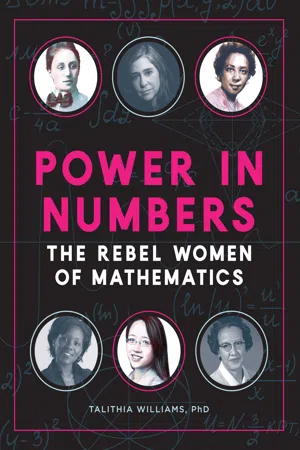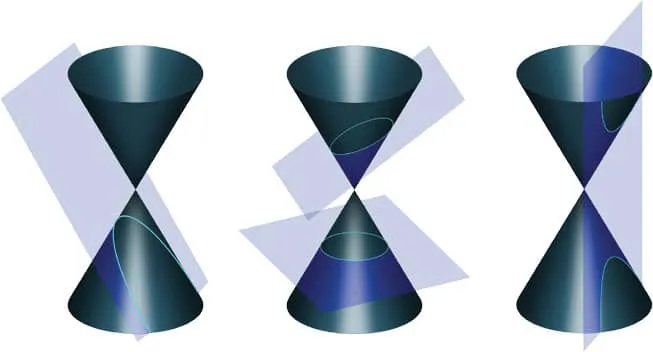PART 1
The Pioneers
The field of mathematics is not known for being especially friendly or appealing to women throughout history, but with the explosion of sophisticated technology in the twentieth century and beyond, many female mathematicians are making essential contributions to all kinds of human endeavors, from bioinformatics to spaceflight. The rise of universities in Ancient Greece laid the groundwork for modern university education and eventually for the breakthroughs of today, with teachers presenting subjects like philosophy and rhetoric alongside mathematics and astronomy. One such professor was Theon of Alexandria (ca. 335–ca. 405), who taught mathematics at the local university and wrote commentaries on some of the greatest scientific works of Ancient Greece, including Euclid’s Elements and Ptolemy’s Almagest. Theon passed his passion for learning to his daughter Hypatia (d. 415), who helped him write those commentaries and whose reputation would surpass his own.
Hypatia studied philosophy, astronomy, and mathematics in Athens, Greece, before she became head of the Neoplatonist school in Alexandria around the turn of the fifth century. She was a particularly skilled speaker, and many people from other cities flocked to the intellectual center of Egypt to hear her lectures. Within mathematics, she is best known for her work on Apollonius’s treatise on conic sections, which divided cones into different parts using flat geometric planes and introduced the concepts of the parabola, hyperbola, and ellipse.
Like too many women in this book, Hypatia paid a heavy price for her pursuit of knowledge, though her story is the most gruesome. As recounted in the 2009 film Agora (and countless plays and works of fiction throughout history), the Bishop of Alexandria spread virulent rumors about her, and one day in 415, she was attacked by a Christian mob, stripped, stabbed to death with broken pottery, and dragged through the streets.
When a double cone is intersected by a plane, the parabola (left), ellipse (center), and hyperbola (right) are created.
An 1865 engraving depicting the death of Hypatia.
It is almost certain that other female mathematicians quietly carried on her legacy through the European Medieval period, the Chinese Song Dynasty, the Islamic Golden Age, and the Renaissance, but there is little record of female achievements in mathematics prior to the publication of French mathematician and philosopher René Descartes’s monumental treatise Discourse on the Method—original source of the famous expression cogito ergo sum (“I think, therefore I am”)—in 1637. Just four years later, a French woman of obscure origins named Marie Crous published a study on the decimal numerical system, which introduced the decimal point that is central to our modern notation. A hundred years after that, Frenchwoman Émilie du Châtelet (1706–1749) published Institutions de Physique (Foundations of Physics), which explained and analyzed the cutting-edge mathematical ideas of Gottfried Leibniz, who later became co-discoverer of calculus, with Sir Isaac Newton. Naturally rumors spread that Châtelet was merely rehashing the lessons of her tutor Samuel Koenig, but in the end several prominent scientists came to her defense, and she was elected to the Academy of Sciences of the Institute of Bologna in 1746. Two years later, the Italian mathematician Maria Gaetana Agnesi (1718–1799) published one of the first and most complete textbooks on finite and infinitesimal analysis: Instituzioni Analitiche (Analytical Institutions). The book was widely translated, and in 1750 Pope Benedict XIV appointed her to the chair of mathematics and natural philosophy at the University of Bologna, making her the first woman in history ever to be appointed to a mathematics university professorship.
Jumping ahead to 1890, we arrive in Cambridge, England, where Philippa Fawcett (1868–1948) has just become the first woman to earn a top score on the annual Mathematical Tripos exam (beating out all her male classmates), and students Isabel Maddison (1869–1950) and Grace Chisholm (1868–1944) are studying calculus and linear algebra at Girton College. Two years later, Maddison and Chisholm passed the Tripos exam, earning the equivalent of first-class degrees in mathematics from Cambridge. (Women were not granted formal degrees at the time.) They also challenged each other to complete the mathematics exam for the Final Honors School at Oxford, and this time Chisholm outperformed all other entrants.
Detail of an eighteenth-century painting of Du Châtelet at her desk.




